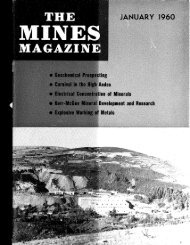What to do about CO2 - Mines Magazine - Colorado School of Mines
What to do about CO2 - Mines Magazine - Colorado School of Mines
What to do about CO2 - Mines Magazine - Colorado School of Mines
You also want an ePaper? Increase the reach of your titles
YUMPU automatically turns print PDFs into web optimized ePapers that Google loves.
By Karla Gor<strong>do</strong>n<br />
The effort <strong>to</strong> mold future scientists, mathematicians<br />
and engineers begins early and Colora<strong>do</strong> <strong>School</strong> <strong>of</strong><br />
<strong>Mines</strong> is helping with the effort. As a former direc<strong>to</strong>r <strong>of</strong><br />
the National Science Foundation (NSF) said, “We cannot<br />
expect the task <strong>of</strong> science and math education <strong>to</strong> be the<br />
responsibility solely <strong>of</strong> K-12 teachers while scientists,<br />
engineers and graduate students remain busy in their<br />
university labora<strong>to</strong>ries.” Over the past three years, four<br />
projects at <strong>Mines</strong>, funded by the NSF, the Colora<strong>do</strong><br />
Commission on Higher Education, the Colora<strong>do</strong><br />
Department <strong>of</strong> Education and others, have focused on<br />
providing middle-school teachers with instruction in<br />
mathematics and science in order <strong>to</strong> improve the<br />
educational experiences <strong>of</strong> middle-school students. The<br />
goal is <strong>to</strong> help teachers develop hands-on classroom<br />
learning environments that illustrate how mathematics<br />
can be applied <strong>to</strong> earth science and engineering.<br />
Each <strong>of</strong> the four projects holds eight- <strong>to</strong> 10-day<br />
workshop sessions designed around a theme and that<br />
demonstrate hands-on activities <strong>to</strong> illustrate the value <strong>of</strong><br />
math and science in real-world problem solving. Cathy<br />
Skokan BSc Geop ’70, MSc Geop ’72, PhD Geop ’75,one<br />
<strong>of</strong> the program direc<strong>to</strong>rs, says that in the real world,<br />
math and science always work in concert. The activities<br />
for participants include building bridges out <strong>of</strong> Popsicle<br />
sticks,<br />
re-engineering<br />
a diaper,<br />
designing a<br />
water filtration<br />
system using<br />
sand, learning<br />
how <strong>to</strong> <strong>do</strong> an<br />
energy audit<br />
and inventing<br />
musical<br />
instruments. At<br />
the end <strong>of</strong> the<br />
workshop, each<br />
participant receives $500 <strong>to</strong> purchase supplies <strong>to</strong> take<br />
back <strong>to</strong> their schools. Teachers then use ideas and<br />
materials from the workshops in their middleschool<br />
classrooms.<br />
Pr<strong>of</strong>essors Barbara Moskal and Skokan direct and<br />
coordinate the workshops, but they’ve recently delegated<br />
the responsibility <strong>of</strong> teaching the workshops <strong>to</strong> graduate<br />
fellows. Doing so allows them <strong>to</strong> travel and present the<br />
project at conferences in an effort, Moskal says, “<strong>to</strong> share<br />
our methods and results with respect <strong>to</strong> K-12 outreach<br />
with our national and international colleagues.”<br />
Last year, the pr<strong>of</strong>essors went <strong>to</strong> Florida,<br />
Utah, China and India; this year<br />
they’ll go <strong>to</strong> Oregon, Australia and Poland. In addition,<br />
graduate students promote the program by making<br />
presentations <strong>about</strong> the workshops at national<br />
conferences.<br />
All <strong>of</strong> the projects also include follow-up classroom<br />
visits from CSM faculty or graduate students in which the<br />
teachers receive assistance in implementing hands-on<br />
mathematics and science instruction. In the GK-12<br />
Learning Partnership project, graduate students provide<br />
direct support in the classroom <strong>to</strong> a given teacher for 10 <strong>to</strong><br />
15 hours each week. In the Physical Science & Mathematics<br />
project, students provide help in the classroom for one<br />
hour every other week. The appropriate amount <strong>of</strong><br />
support needed is currently being scientifically analyzed.<br />
Keith Hellman, one<br />
<strong>of</strong> the CSM<br />
graduate students<br />
who spends time<br />
in several schools<br />
each week, says the<br />
most exciting<br />
aspect <strong>of</strong> the<br />
experience is that<br />
“students can ask<br />
very insightful and<br />
very motivated<br />
questions.”<br />
Hellman has been<br />
surprised, he says, “by how much work it takes <strong>to</strong> be a<br />
good teacher and how much pressure teachers are under <strong>to</strong><br />
show progress on<br />
assessments. Our<br />
culture <strong>do</strong>es not<br />
<strong>do</strong> enough <strong>to</strong><br />
reward, encourage<br />
and assist the<br />
people who,<br />
arguably, have the<br />
most influence<br />
over our future.”<br />
Skokan explains<br />
that middle<br />
schools rather than<br />
high schools were<br />
chosen as partners<br />
because middle-school teachers <strong>of</strong>ten <strong>do</strong>n’t hold degrees in<br />
the subjects they teach, so they may lack content<br />
knowledge. These teachers need an opportunity <strong>to</strong> learn<br />
and understand the concepts they are required <strong>to</strong> teach.<br />
Further, research shows that middle school is a crucial<br />
time for kids. Moskal, the GK-12 Learning Partnership<br />
project direc<strong>to</strong>r, says that it’s during the middle-school<br />
years that students may opt out <strong>of</strong> the academic classes<br />
that are prerequisites for advanced science and<br />
mathematics courses in high school and beyond. “Students<br />
from low-income families are at an even greater risk <strong>of</strong><br />
displaying weak mathematical and scientific knowledge<br />
when compared <strong>to</strong> their middle-class peers,” Skokan adds.<br />
To increase the number <strong>of</strong> students who continue their<br />
education in<strong>to</strong> higher mathematics and science, she says,<br />
“It’s important <strong>to</strong> provide activities that excite students.<br />
By showing kids that there are meaningful, real-world<br />
applications, we stand a better chance <strong>of</strong> not only<br />
holding their interest, but also that they might pursue<br />
6<br />
MINES SPRING 2005<br />
C0LORADO SCHOOL OF MINES<br />
7<br />
MINES SPRING 2005<br />
C0LORADO SCHOOL OF MINES

















